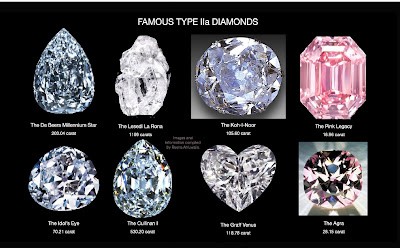Diamonds are not just symbols of luxury and elegance; they are also marvels of nature and science. Each type of diamond possesses distinct features, colors, and origins that contribute to its allure and value. Below, we explore ten remarkable diamond types, highlighting their unique attributes and estimated market values.InStyle
1. Red Diamonds
-
Color: Intense red
-
Rarity: Extremely rare
-
Notable Example: Moussaieff Red Diamond (5.11 carats)
-
Estimated Value: Over $1 million per carat
-
Per Ounce Estimate: Approximately $141 milliondiamantes.com+1Home Quirer+1Rock Chasing+4Wikipedia+4Wikipedia+4
Red diamonds are the rarest and most expensive colored diamonds, with very few known specimens. Their captivating hue is believed to result from structural anomalies during formation. Wikipedia
2. Blue Diamonds (Type IIb)
-
Color: Blue to grayish-blue
-
Rarity: Very rare (≈0.1% of natural diamonds)
-
Notable Example: Blue Moon of Josephine
-
Estimated Value: $3 million–$4 million per carat
-
Per Ounce Estimate: $423 million–$564 milliondiamantes.com+8Wikipedia+8Rarest.org+8Wikipedia+2Rock Chasing+2Rarest.org+2Wikipedia+2Rarest.org+2New York Post+2Wikipedia
Blue diamonds owe their color to boron impurities and are among the rarest natural diamonds. Their unique composition also allows them to conduct electricity. Rarest.org+1Wikipedia+1
3. Pink Diamonds
-
Color: Fancy pink to vivid pink
-
Rarity: Rare
-
Notable Example: Pink Legacy (18.96 carats)
-
Estimated Value: $2 million–$2.6 million per carat
-
Per Ounce Estimate: $282 million–$367 millionWikipedia+1Rock Chasing+1
Pink diamonds are highly sought after for their romantic hue. The Pink Legacy set a record at $2.6 million per carat when sold at auction. Wikipedia
4. Yellow Diamonds (Type Ib)
-
Color: Bright yellow to canary yellow
-
Rarity: Moderately rare
-
Notable Example: Tiffany Yellow Diamond (128.54 carats)
-
Estimated Value: $10,000–$50,000 per carat
-
Per Ounce Estimate: $1.4 million–$7 millionWikipediadiamantes.com+1Brides+1Rock Chasing
Yellow diamonds get their color from nitrogen impurities. The Tiffany Yellow Diamond is one of the largest and most famous of its kind. Rock Chasing
5. Orange Diamonds
-
Color: Vivid orange
-
Rarity: Very rare
-
Notable Example: The Pumpkin Diamond
-
Estimated Value: $100,000–$300,000 per carat
-
Per Ounce Estimate: $14 million–$42 millionRarest.org+1Wikipedia+1Rock Chasingdiamantes.com+2Wikipedia+2Ivana Jewels+2
Orange diamonds, also known as "fire diamonds," are prized for their fiery hue. The Pumpkin Diamond is a notable example displayed at the Smithsonian Institution. Rock Chasing
6. Green Diamonds
-
Color: Light to deep green
-
Rarity: Rare
-
Estimated Value: $50,000–$100,000 per carat
-
Per Ounce Estimate: $7 million–$14 millionRarest.org+2Wikipedia+2Wikipedia+2
Green diamonds acquire their color through natural radiation exposure over millions of years, making them unique and valuable. Brides
7. Purple Diamonds
-
Color: Lavender to deep purple
-
Rarity: Extremely rare
-
Notable Example: Elizabeth Taylor Diamond
-
Estimated Value: $100,000–$200,000 per carat
-
Per Ounce Estimate: $14 million–$28 millionRarest.orgHome Quirer+6Rock Chasing+6Wikipedia+6
Purple diamonds are among the rarest colored diamonds, often associated with royalty and luxury.
8. Brown Diamonds (Champagne & Cognac)
-
Color: Light brown to deep cognac
-
Rarity: Common
-
Estimated Value: $2,000–$4,000 per carat
-
Per Ounce Estimate: $282,000–$564,000diamantes.com+1WSJ+1WSJ+1Wikipedia+1
Once undervalued, brown diamonds have gained popularity for their warm tones and affordability. Ivana Jewels+3WSJ+3Brides+3
9. Black Diamonds
-
Color: Opaque black
-
Rarity: Moderately rare
-
Estimated Value: $3,000–$5,000 per carat
-
Per Ounce Estimate: $423,000–$705,000WSJ+2diamantes.com+2Home Quirer+2
Black diamonds, known for their unique appearance, are popular in modern jewelry designs.
10. Lab-Grown Diamonds
-
Color: Virtually all colors (depending on creation method)
-
Rarity: Readily available
-
Notable Example: Diamond Foundry’s brilliant lab stones
-
Estimated Value: $800–$1,200 per carat
-
Per Ounce Estimate: $112,800–$169,200
Lab-grown diamonds are chemically identical to natural diamonds but are created in a controlled environment using techniques like HPHT (High Pressure High Temperature) or CVD (Chemical Vapor Deposition). They are an ethical and affordable alternative for those seeking sustainable luxury.
💬 Final Thoughts
Diamonds come in a stunning array of colors and types, each with its own story and value. From the fiery beauty of red diamonds to the eco-friendly appeal of lab-grown gems, the diamond world is as diverse as it is dazzling.
As you can see, the price per ounce can vary dramatically — ranging from under a million dollars for black and brown diamonds to hundreds of millions for ultra-rare red and blue varieties. Whether you are a collector, investor, or simply a lover of fine jewels, understanding these types can deepen your appreciation for nature’s most treasured crystal.
📈 Quick Summary Table
| Type of Diamond | Approx. Value per Ounce |
|---|---|
| Red Diamond | ~$141 million |
| Blue Diamond | ~$423M–$564M |
| Pink Diamond | ~$282M–$367M |
| Yellow Diamond | ~$1.4M–$7M |
| Orange Diamond | ~$14M–$42M |
| Green Diamond | ~$7M–$14M |
| Purple Diamond | ~$14M–$28M |
| Brown Diamond | ~$282K–$564K |
| Black Diamond | ~$423K–$705K |
| Lab-Grown Diamond | ~$112K–$169K |
🌟 Diamonds are forever — and so is their fascination.
If you enjoyed this article, feel free to share it or leave a comment below! ✨






.jpg)



.jpg)
.jpg)
Excellent jankari
ReplyDeleteYes
Delete